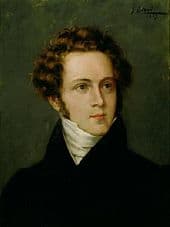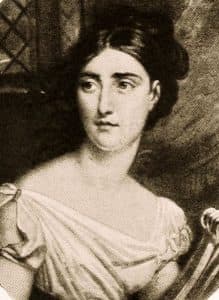Background on the OperaNorma
The history of classical music teems with colorful anecdotes. Does it matter that most of them are fiction? Invented by passionate enthusiasts and often embroidered around a thread of truth, they help us understand and remember. Probably the most famous such story about Vincenzo Bellini, composer of the bel canto masterpiece Norma, is a purported incident from when he was 31 and heard Rossini’s sacred oratorio Stabat Mater. According to the story, the awe-struck Bellini said “If I could write melodies like that, I would be happy to die young.” Three years later he was dead, aged 34, having written dozens of the most beautiful melodies in the operatic literature. We hear some of the most famous in Norma.

Vincenzo Bellini
Your intrepid annotator has uncovered different versions of this incident without being able to confirm any of them. But if we “unpack” the story, as the critics say, there is much to be learned, starting with Bellini’s reverence for a more senior colleague. Bellini was part of the great flowering of artistic genius in late 18th- and early 19th-century Italy that brought bel canto opera to its zenith. The three best-known practitioners of this style—Rossini, Donizetti and Bellini—were born within nine years of each other, Rossini first and Bellini last. Abundance of melody is a hallmark of the style; in fact, its practitioners were once known as “melodists.” Parsing the story more closely, we can understand why it centers on the Stabat Mater: while Rossini’s tunes are typically zestful and propulsive, Bellini’s are usually smoother and more flowing, often with extended legato lines—the kind we hear in the atypical Stabat Mater. In fact, the oratorio’s moving “Fac ut portem” section sounds like vintage Bellini.
Bellini was born in the Abruzzi region of Italy in the town of Catania, first-born among seven children. The family was highly musical; his grandfather had attended conservatory in Naples, and both his father and his grandfather were highly respected as organists, teachers of music, and maestri di capella at the local church. From an early age, Vincenzo’s talent was perceived as extraordinary, and his father began Vincenzo’s instruction at the keyboard years before the boy reached school age. Later he received private instruction with a local priest and showed a prodigy’s aptitudes in both music and academics—in performance at the keyboard (age 5), composing (age 6), and languages, rhetoric and philosophy (age 7). He entered the conservatory in Naples at age 18, and after he led fellow-students there in a public performance of his student opera Adelson e Salvini, his career as an opera composer was launched.
The historical record suggests that from childhood onward, Bellini’s brief life was a steady, unhindered ascent powered by talent, inspiration and discipline; in addition to his artistic gifts, his personal charm gave him entrée to elite social circles in Italy and France. By the time he conceived the idea for the opera that was destined to be his greatest, Norma, he was only 28 years old, but had an international reputation. He composed the work as half of a double commission for Italy’s foremost opera house, La Scala in Milan, for production in 1830. Further proof that his career was already thriving: he commanded the unheard-of fee of 12 thousand lire for Norma.
Norma is an innovative opera, and even before opening night, its newness posed challenges. Bellini created the title role on Giuditta Pasta, a compelling vocal actress who at first balked at the demands of her now-legendary opening aria, the fearsome “Casta diva.” With Bellini’s persuasion and coaching, the real-life diva soon came to appreciate “Casta diva,” which is sung as a Druidic invocation to the “chaste goddess,” the moon. But the public followed the same pattern as Mme. Pasta herself, initially resisting Norma’s unconventionality. The second night audience was more receptive, and soon the Italian public clamored for productions. Within a few years, newspaper reviews in Italy and elsewhere could proclaim “Norma conquers Europe.”

Giuditta Pasta
To understand Norma’s originality we must consider it in the context of bel canto, a genre of some controversy even now. A style of both singing and composition, bel canto excited its contemporary audiences as a showcase for spectacular vocal display and histrionic extremes. In addition to their beautiful melodies, bel canto operas were filled with da capo arias that repeated their opening sections, which were sung with wildly elaborate ornamentation the second time around. Composers strove for vocal ornament that would intensify the dramatic and aesthetic qualities of the moment, but listeners hungered for the sheer thrill of seemingly impossible vocal feats. All those fioritura—trills and runs that were often improvised on the spot—are what Beverly Sills was talking about when she quipped that coloratura singers should be paid by the note. The heroines of these operas were often wilting flowers who, in their fragility, would go mad from the stress of conflict or romantic disappointment, and whose only hope was to be rescued by a man. Their “mad scenes” were a staple of the form, and were invariably the dramatic climax of the opera, crammed with spectacular vocal pyrotechnics reflecting the pathetic soprano’s stress and her fractured mind. Bellini certainly composed his share of these. His 1834 opera I puritani even contains two mad scenes for its lovesick heroine, Elvira—one when she loses her sanity, and one when she gets it back.
By comparison, the Druid priestess Norma could not seem more different or more modern. She is a strong woman in a position of high responsibility who remains in charge of her own destiny at every moment. Her tragic conflicts arise from mature relationships—with her best friend, who becomes her romantic rival; with her two children, born and reared in secret; with her clandestine lover, whom she ultimately renounces; and with the people who look to her for spiritual leadership. The operatic literature offers no more moving example of personal courage than when Norma announces to her community that their unknown betrayer must be punished with death, and then says “son’ io” — “it is I.” Accordingly, her music’s most difficult demands are not its floridity (though there’s lots of that) but its emotional weight and the stamina required to sustain it.
Thanks to Bellini’s diligent (and often hard-fought) work with librettist Felice Romani, Norma reaches the most successful union of words and music in any bel canto opera. Over the years, this achievement has drawn admiration from some unlikely sources. Richard Wagner, who was in his mid-twenties when Norma became popular and who was harshly critical of most Italian opera, wrote at length of his admiration for the dramatic unity of Bellini’s expressive, songlike melodies and the libretto they serve. Even the German philosopher Arthur Schopenhauer, prince of pessimism, declared his admiration for Norma as an opera that embodies the virtues of classical tragedy. But in this very rare instance, one of Wagner’s comments seems just right: “Bellini,” he said, “wrote from the heart.”
Michael Clive’s writing on music and the arts has appeared in publications throughout the U.S. and in the U.K., as well as on the Internet (for Classical TV.com and Classical Review) and television (for the PBS series Live From Lincoln Center). He is program annotator for the Utah Symphony, the Louisiana Philharmonic Orchestra and the Pacific Symphony, and is editor-in-chief of The Santa Fe Opera.


